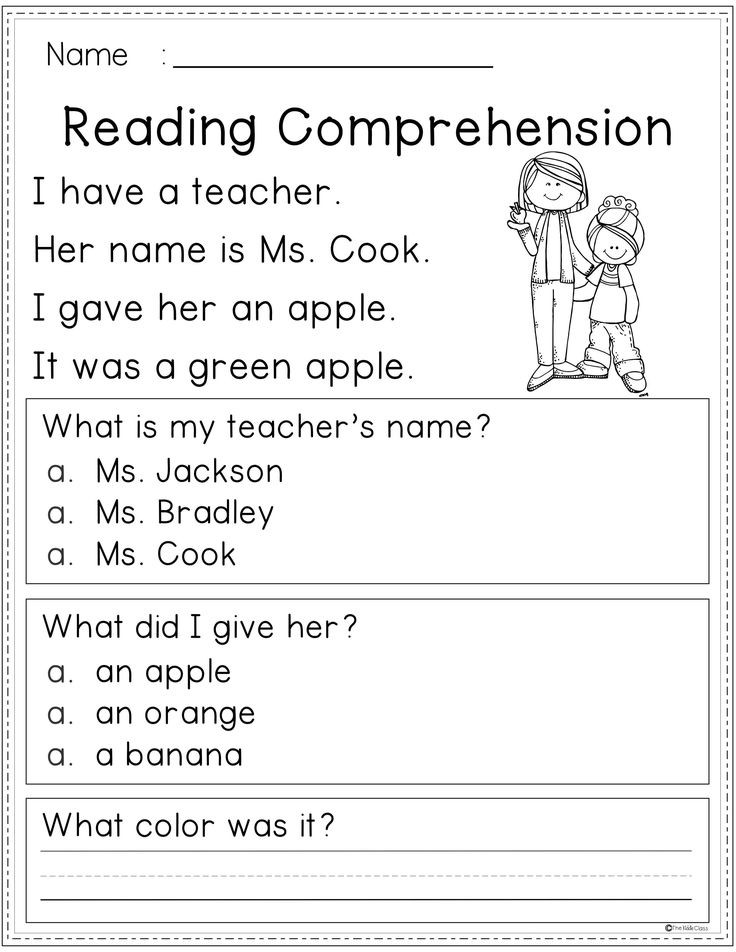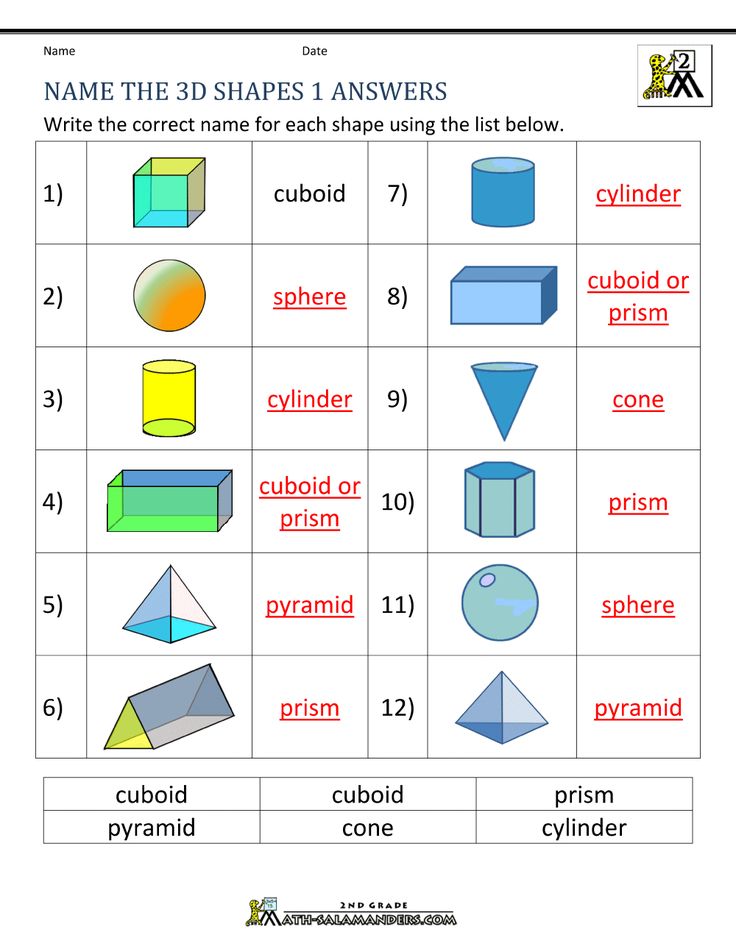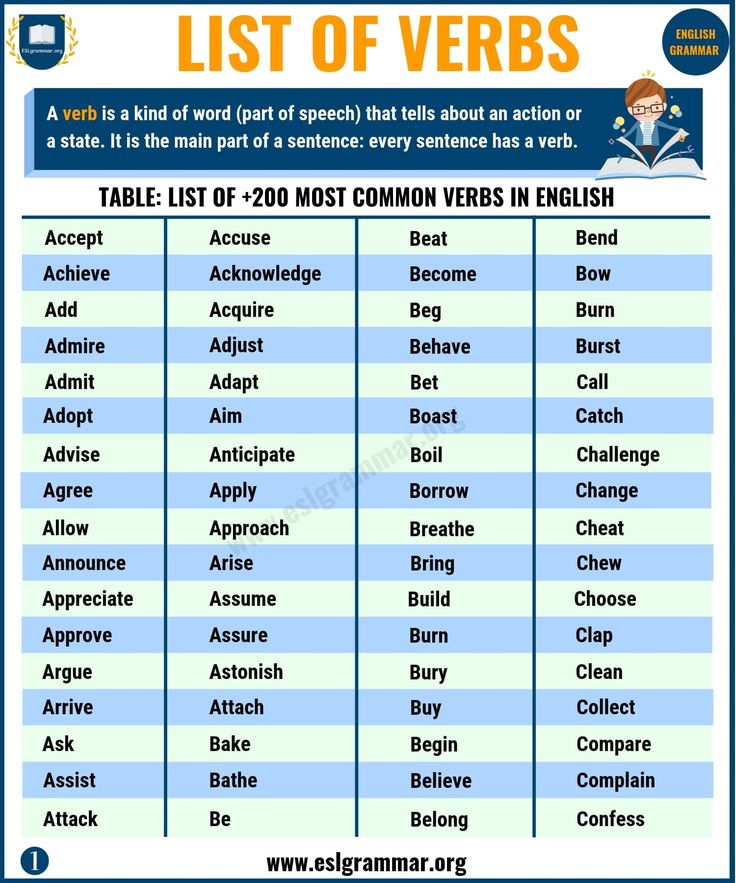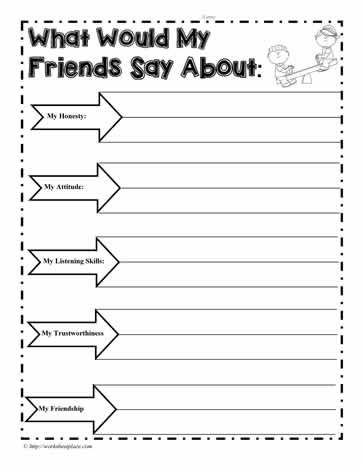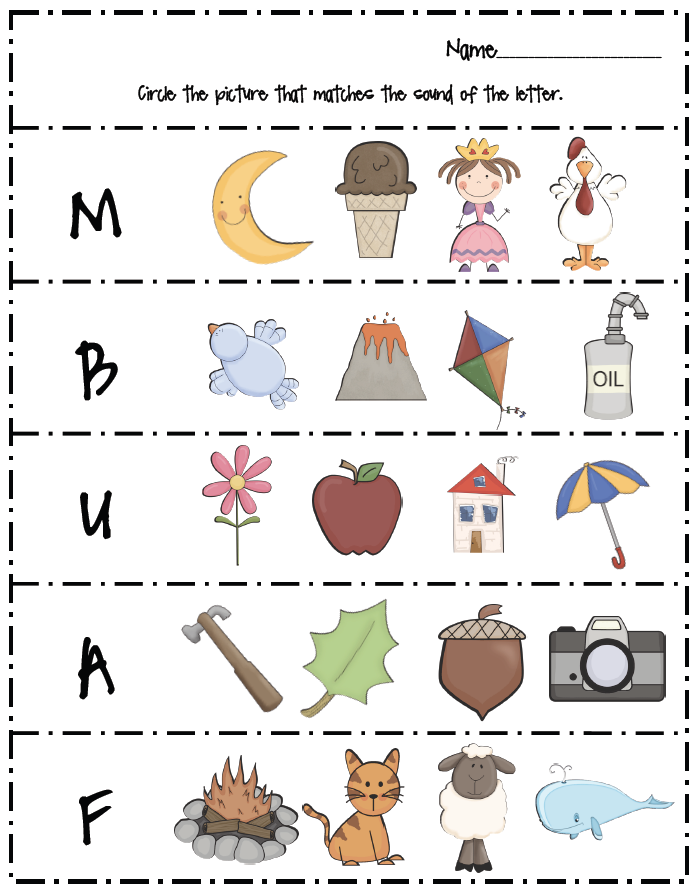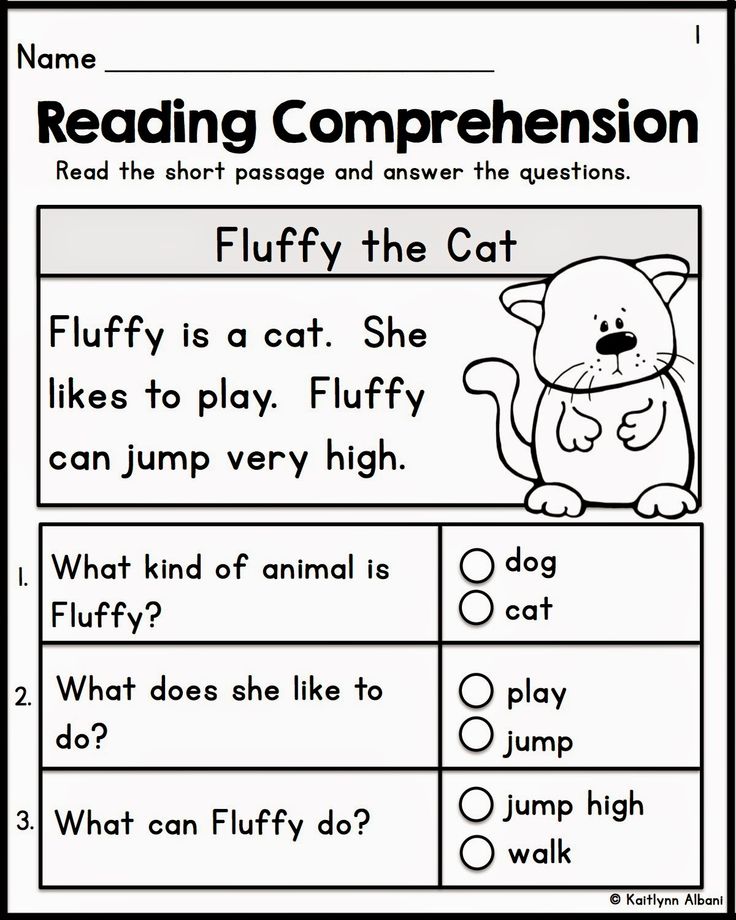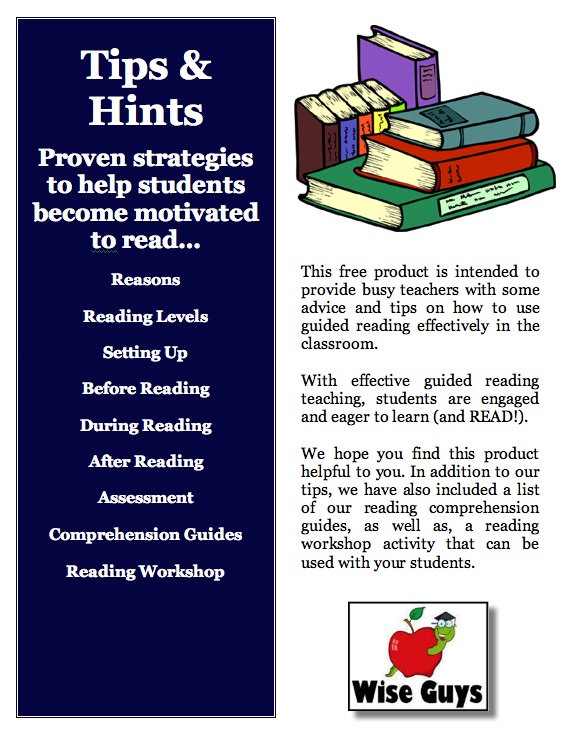Open and closed syllable games
Open and Closed Syllable Games
*This post contains affiliate links.
If you’ve read my blog for very long, you know I’m a huge fan of making literacy as hands-on as possible. To teach my oldest reader (2nd grade), we mainly use the Words Their Way word sorts and the letter tiles from All About Reading/All About Spelling. But every once in a while, it’s fun to just play games with words! And that’s what we did when we played these open and closed syllable games together.
We have been working on reading two-syllable words and I’ve been moving through the graphic organizer that I created for him. I have to be very explicit with him (and that’s okay). Reading two-syllable words has not come naturally, despite his ability to read one-syllable patterned vowels well.
What are Open and Closed Syllables?
First, it’s important to understand what an open and closed syllable is. All About Learning Press has a great blog post about it that gives great examples and why readers and spellers even need to learn about them. I’ve also created a little graphic about open and closed syllables that helped ALuv. {see below- this is included the free pack you can download at the end of this post}
Open and Closed Syllable Games
On day 1, we reviewed what open and closed syllables are using the graphic above. To review a bit, we matched all the words in the deck of cards I created and then labeled them as open or closed (free printable at the end of this post).
On day 2, he made words in our pocket chart, matching the 1st and 2nd syllables. He sorted them as either open syllables or closed syllables (focusing on the 1st syllable).
On days 3 and 4, we played a matching game with the various open and closed syllables. On day 3, we played with half the deck (16 cards) and on day 4, we played it with the remaining half of the deck (16 cards).
1- Each syllable card in the pack has a 1 or 2 on it, depending on if it’s the 1st or 2nd syllable.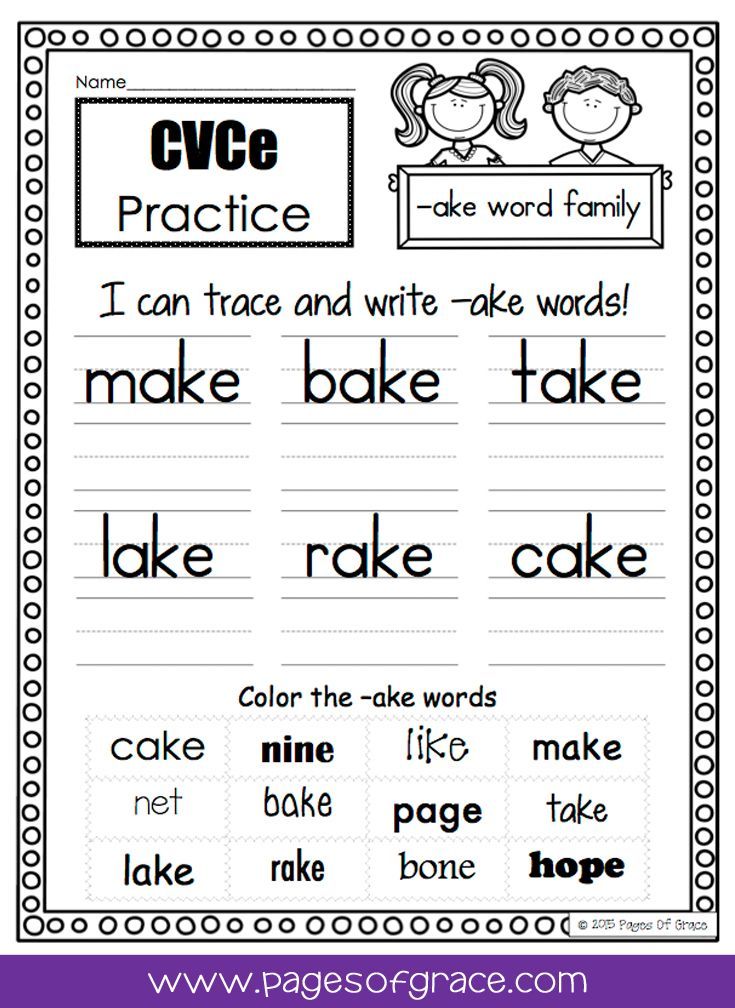 I placed eight 1st syllable word cards on the left side of our playing area (both from the open and closed syllables) and eight 2nd syllable word cards (also from open and closed syllable cards).
I placed eight 1st syllable word cards on the left side of our playing area (both from the open and closed syllables) and eight 2nd syllable word cards (also from open and closed syllable cards).
2. We took turns turning over a 1st syllable card and a 2nd syllable card. The player had to read the word created on his turn (a fun way to practice reading silly words in a meaningful way AND a great way to work on reading those open and closed syllables).
3. The ultimate goal was to match the 1st and 2nd syllable cards to make a real word (they only match one way). When a player made a match, he kept the two cards and got another turn.
On day 5, we played Open and Closed Syllable Twister {inspired by Mom to 2 Posh Lil Divas}! He LOVED this!
To prep, I placed the 1st syllable cards on one side of the Twister mat and the 2nd syllable cards on the other side of the mat, like you see in the photo above.
I called out words, such as shiny, and he had to find the syllables of the word on the mat and place his hand and foot on the correct circles to spell each word.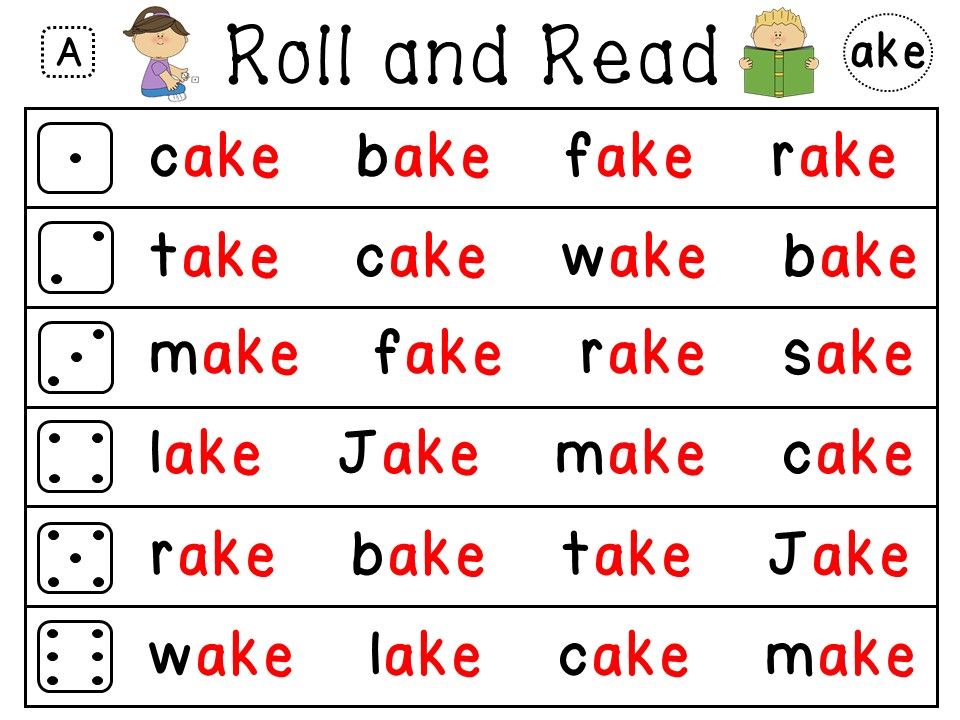
*You can adapt this game by using prefixes + root words or root words + suffixes.
More Resources for Reading Longer Words:
- Strategies for Reading Longer Words– FREE printable page of strategies for kids
- Reading Longer Words with free printable baseball-themed pack {base words and inflected endings}
- Reading Two-Syllable Words with Easter Eggs
- Word Study: It’s WAY More than Phonics
Follow This Reading Mama’s board Word Study/Phonics on Pinterest.
Enjoy teaching!
~Becky
Want MORE Free Teaching Resources?
Join thousands of other subscribers to get hands-on activities and printables delivered right to your inbox!
Open and Closed Syllables Games and Activities
Learning to read and write
open and closed syllables is a foundational skill for multisyllabic decoding. Learning to read part of a word helps students break down longer words into more manageable chunks and assists students in discovering patterns in spelling words. Teaching and giving students practice working with open and closed syllables is a must for creating successful readers.
Teaching and giving students practice working with open and closed syllables is a must for creating successful readers.
Open syllables happen when there is a vowel at the end of the syllable. The vowel makes a long vowel sound, like the word robot. The first syllable, ro, has a long o. Here are a few more examples
- ba / by
- pi / lot
- ho / tel
Closed syllables happen when there is a consonant at the end of the syllable. The vowel sound in the syllable makes a short vowel sound, like habit. The first syllable, hab, has a short a. A few more examples include:
- sub / mit
- lem / on
- mag / net
There are exceptions to these rules, but they occur often enough that it is beneficial to explicitly teach the concept to students. I don’t necessarily teach my younger learners the names open and closed syllables, but instead, teach and give practice about the concept.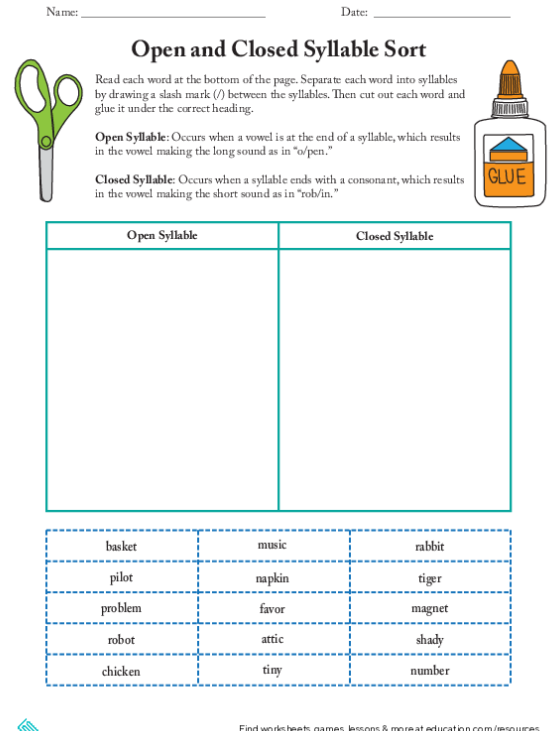
There are six different syllable types, but open and closed syllables are the easiest to teach and learn. Hundreds of words can be read and written with a basic understanding of open and closed syllables. Knowing these syllable types will help students be a better speller, but also better readers.
It is also a foundation for multisyllabic reading. Larger words are built off the smaller chunks of two-syllable words. When reading and spelling multisyllabic words, students should be able to break the word apart into syllables and then decipher each syllable independently to build the word.
Like reading, teaching open and closed syllables is great for spelling. Words that have a double consonant are often difficult to spell. Students only hear one of the consonants when spelling. However, if students are taught that a short vowel is followed by a consonant, they will learn that mit/ten must have two “t’s” in the word.
I created a product to help my students master reading two-syllable words and then created a complimentary product for open and closed irregular syllables.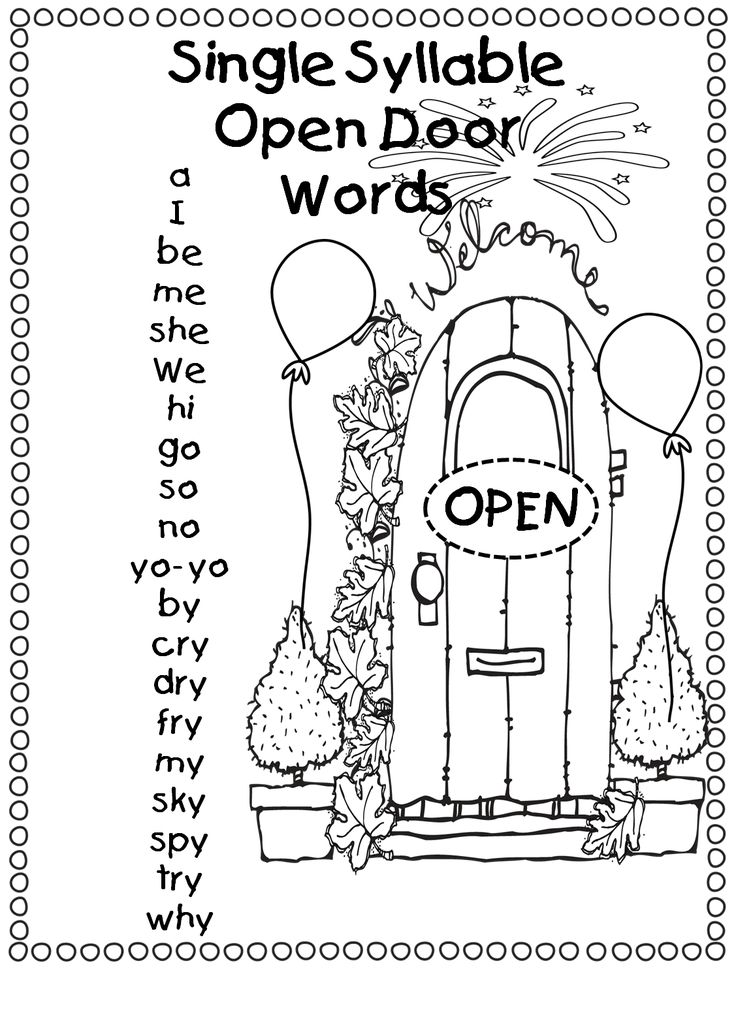 The Open and Closed Syllables sets have over 12 different activities and games to use during small group reading or for independent reading activities. All the games and activities focus on students reading and breaking apart words into syllables.
The Open and Closed Syllables sets have over 12 different activities and games to use during small group reading or for independent reading activities. All the games and activities focus on students reading and breaking apart words into syllables.
Irregular syllables don’t follow standard decoding practices. Examples include able, ible, tion, ance, etc.
The two sets of syllable work have similar components and include the following resources and activities:
- Anchor Charts
- Syllable Cards and Word Cards
- Sorts
- Read Words by Syllables
- Fluency Strips
- Break Apart into Syllables
- Puzzles
- Cut & Paste
- Roll & Spin
- Match Missing Syllable
- Flip Books (great for Interactive Notebooks!)
- Board Games
- Coloring Sheets
Answer Keys are included for all worksheets. Below are a few descriptions and photos from the Open and Closed Syllables packet.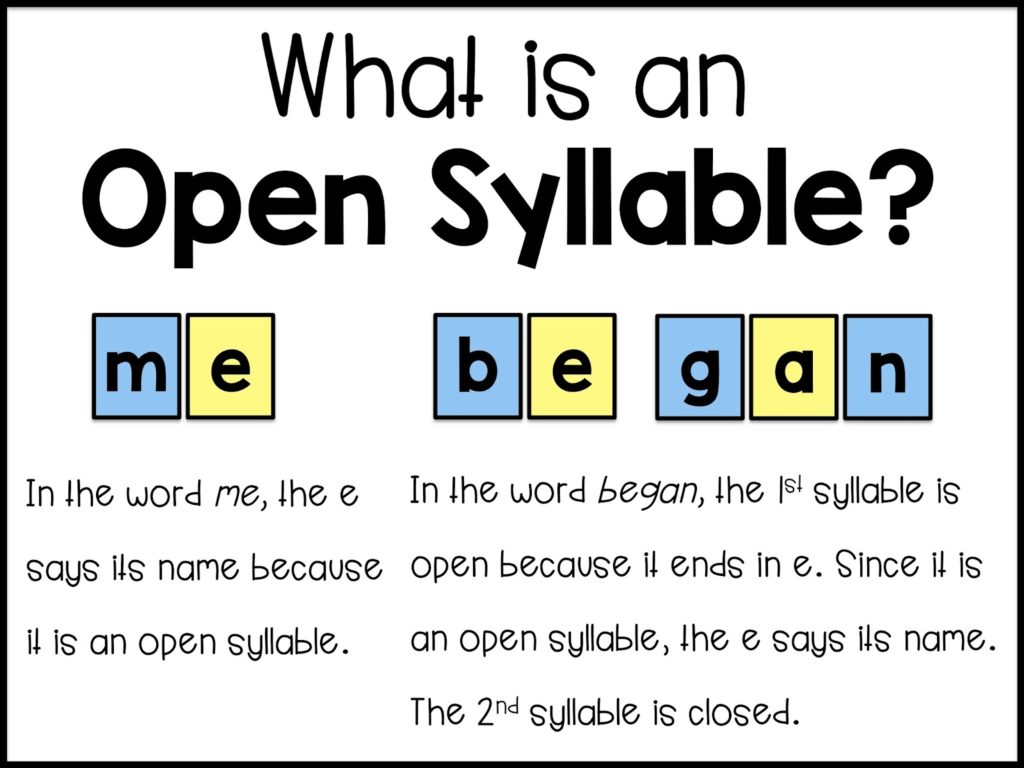
Open and Closed Syllables: Missing Syllables
In this activity, students match the missing part of the syllable to create a complete word. You can laminate the cards, cut them apart, and put then them on a ring to make it all a bit more organized. Color coding the cards and missing syllable would help, too. Print the missing syllable on colored paper and add the same colored mark to the picture card.
The missing syllable cards are designs so that, when possible, the text is justified based on whether it is the first or second syllable of the word. This will also help students see patterns in the syllables.
Open and Closed Syllables: Puzzles
My students love working with puzzles. There’s just something about then that makes an activity ten times more engaging. The pieces are such that it is easy to see which is the first and second syllable based on the type of puzzle piece.
Open and Closed Syllables: Roll & Spin
Since there are two parts to the words, this roll and spin game is a perfect addition to any reading station. Students spin the spinner for the first syllable and roll the dice for the second syllable. Put the two together and figure out if it is a real word! This is a great activity to help with spelling as students are expected to write down each syllable then put the word together.
Students spin the spinner for the first syllable and roll the dice for the second syllable. Put the two together and figure out if it is a real word! This is a great activity to help with spelling as students are expected to write down each syllable then put the word together.
Open and Closed Syllables: Syllable or Not Syllable
This worksheet is a great way for your learners to discover patterns within syllables, namely that a syllable has to have a vowel. It also helps students familiarize themselves with common syllable chunks.
Open and Closed Syllables: Match the Syllables
Like the above worksheet, this one deals with syllable chunks. Students match the missing part of the word to the given part then write the whole word on the blank space. Not only does this focus on becoming familiar with a variety of chunks of words, but it also helps students put the two parts together into the word.
You can purchase either set of the syllable games and activities on my website or on Teachers Pay Teachers.
- Open and Closed Syllables for Two-Syllable Words (TpT)
- Open and Closed Irregular Syllables (TpT)
Games used to correct violations of the syllabic structure of words
- Information
- For parents
- Tips from a speech therapist
- Games used to correct violations of the syllabic structure of words
Games used to correct violations of the syllabic structure of words
Prepared by speech pathologist1. "Add words" game
Purpose: working out disyllabic words from open syllables, with a closed syllable, with a confluence of consonants, making sentences with a given word, finding a given sound in a word, forming singular and plural nouns, clarifying, enriching the verb dictionary, classifying objects, developing attention, logical thinking . nine0016
- "Fold puzzles"; make a word from two parts, name the stressed syllable, come up with a sentence with this word, find the given sound, the place of the sound in the word.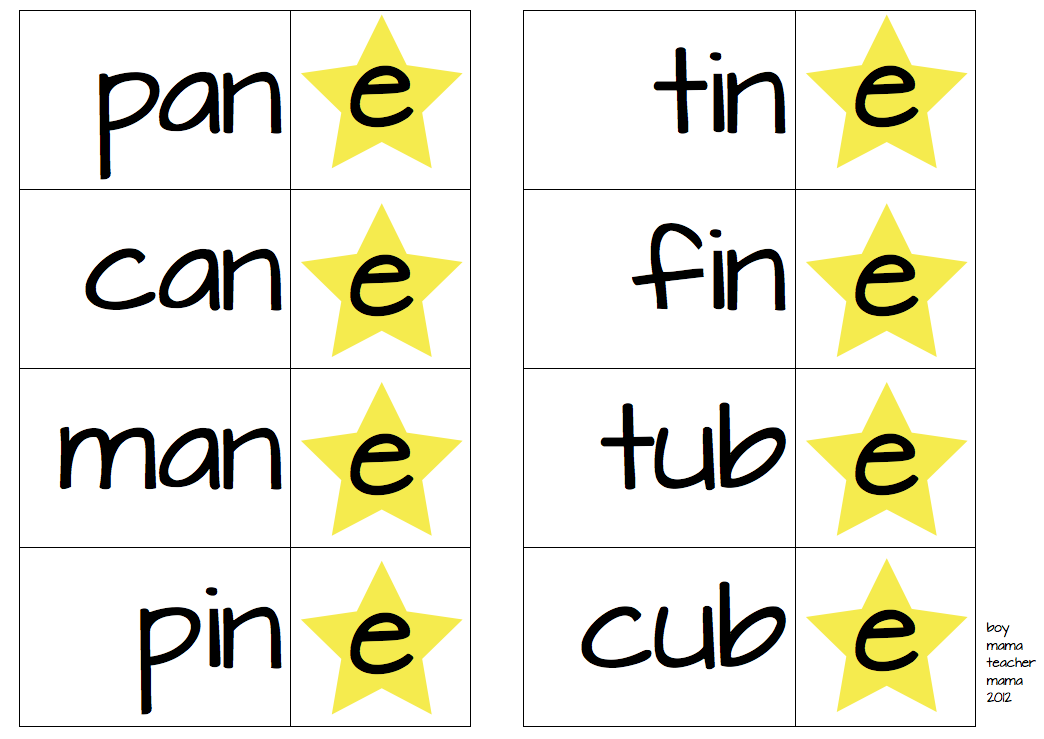
- "Build a chain of words"; classification of objects on a given topic, find words with a given syllable.
- "What has changed in the word?"; find words in the singular and plural, come up with sentences with these words.
- "Find a picture"; put together a word of two syllables, choose the right picture, come up with a sentence using the resulting verbs. nine0016
- "Find the right house"; add words, insert into the table, focusing on the color on the cards.
- "Add a word from syllables" - Connect the syllables, read the word. (First with support on the picture, then without support).
2. "Entertaining cards" game
Purpose: working out two-syllable and three-syllable words from open syllables, with a closed syllable, with a confluence of consonants, finding a given sound, a syllable in a word, making sentences with a given word. nine0016
- Fold the picture (the picture is cut into as many parts as there are syllables in the word), name the stressed syllable, find the given sound, the place of the sound in the word, come up with a sentence with this word.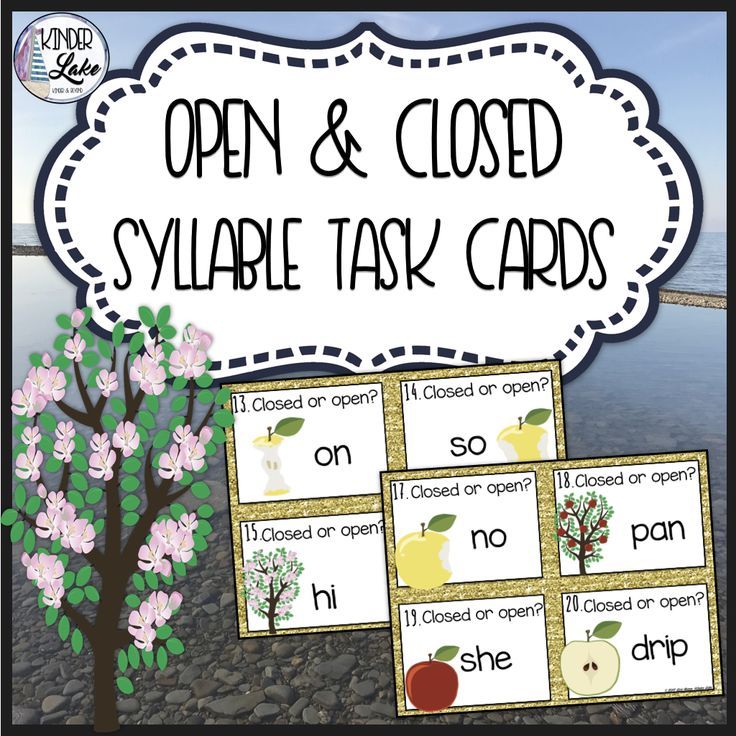
– Determine which syllable is missing: ko-…-va, sa-…-let.
- Which word is longer, shorter: moon or suitcase, phone or lemon?
- "Living-non-living": choose the right words.
- Add pictures and find words for a given sound.
- Explain the complex words "airplane", "ship". nine0016
3. Game "What word did I have in mind"
Purpose: working out words of different syllabic structure.
- Children are given subject pictures, as many chips are displayed on the typesetting canvas as there are syllables in a word. Children choose words based on the number of chips.
-Find words with a given syllable and the required number of syllables (ka-bi-na, ka-bi-no, ka-re-ta, ka-yu-ta).
4. Game "Spring drops"
Purpose: enrichment, clarification of words about spring, working out words of a complex syllabic structure. nine0016
3 games to practice the same words: spring, drops, flood, icicles, snowdrops, thawed patches.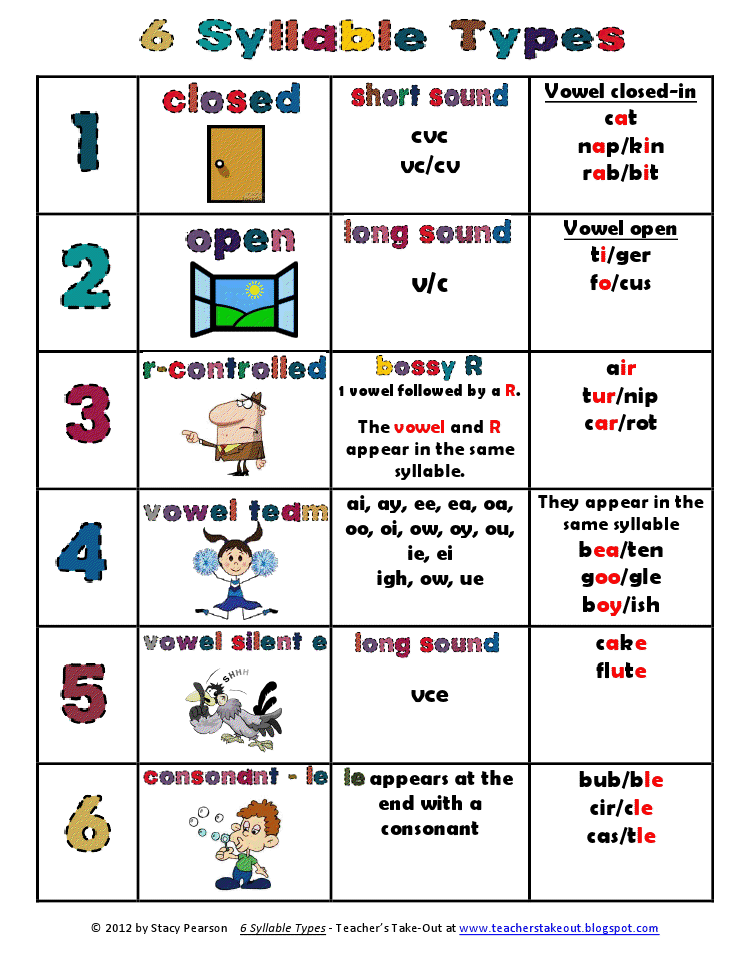
- Colored ice cubes. Put the puzzles together based on the color of the ice cubes.
- "Spring train journey". Compose words from syllables, relying on passengers (dogs ride on one train, ducklings on the other) who ride on the train.
- "Spring rain" (Syllables are written on droplets). Lay out words from syllables on your own.
5. Game "Funny Trains" nine0016
Purpose: working out monosyllabic and two-syllable words, enriching and clarifying the dictionary.
- Pick the right letter or syllable to the beginning of the word, who will find more words.
6. The game "In the garden or in the garden"
Purpose: working out words of different syllabic structures, classification, differentiation on the topic "Vegetables-Fruits", an exercise in inflection, in word formation.
- Put words from syllables, put vegetables in a basket, fruits in a vase.
- One-to-many game. nine0016
Name fruits and vegetables affectionately.
7. Game "Chain of syllables"
Purpose: working out two-syllable words, enriching and clarifying the dictionary, preventing dysgraphia and dyslexia.
- Lay out a chain of words, the end of one word is the beginning of another.
8. Game "Walking around the zoo"
Purpose: working out syllables of different syllabic structures, developing phonemic hearing and syllabic analysis of words.
- The game "Which word is superfluous?" name an extra word: lion, fox, wolf, elephant; bear, fox, hedgehog, hare; monkey, hippopotamus, giraffe, crocodile. nine0016
- The game "Russell animals in enclosures." Help animals find their home, focusing on the syllabic structure of the word.
9. Game "Who is on the train?"
Purpose: acquaintance with the professions of people working in railway transport, working out words with a complex syllabic structure, preventing dysgraphia and dyslexia.
- Put words from syllables, explain what this person does, make a sentence with this word.
Playing with words, you can work out the singular and plural of nouns and verbs, prepositional endings of nouns, learn to determine the gender of nouns. Games: “One-many”, “Nothing?”, “Greedy”, etc. nine0016
Games help to form words with the help of suffixes, prefixes, introduce the formation of complex words. Games: “Say kindly”, “Who has whom?”, “Dishes shop”, etc.
Solving crosswords, chainwords, rebuses allow us to consider the word not only as a lexical, grammatical unit of speech, but also to develop figurative thinking, visual and auditory perception, attention and speech.
The use of a correctional system developed according to the characteristics of the violation of the syllabic structure in children can significantly reduce the severity of this violation. nine0016
How to teach a child to divide words into syllables
Complain
Created by
Schoolchildren study the ability to divide words into syllables in the first grade.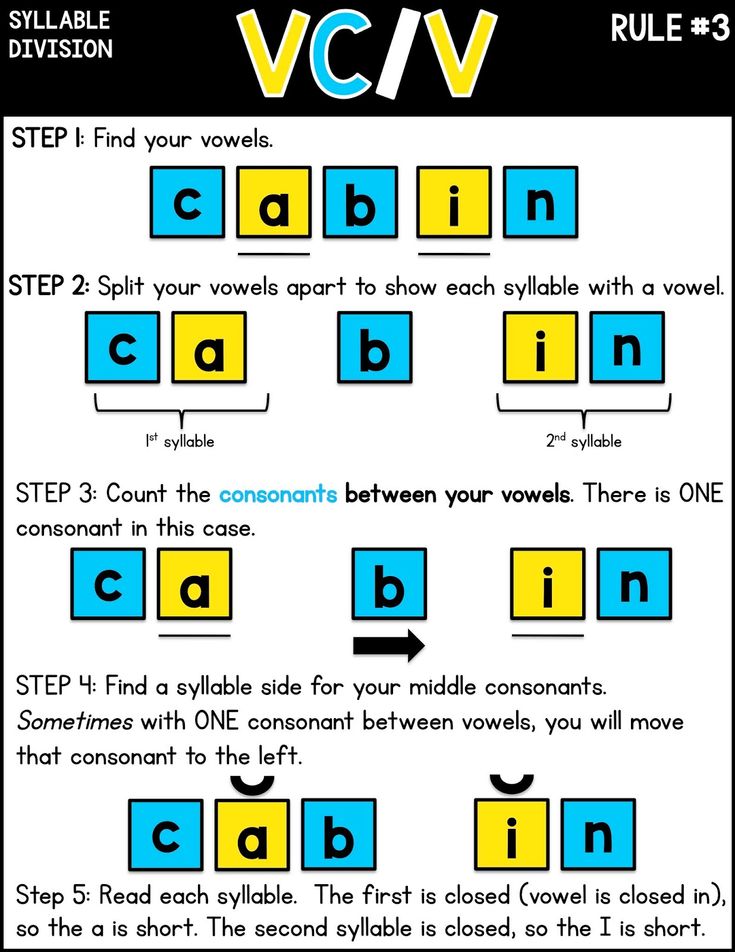 To make the process easy and eliminate the moment when children make mistakes, you can master this science with the help of games. Choose fun and interesting ones. Our selection includes some of them.
To make the process easy and eliminate the moment when children make mistakes, you can master this science with the help of games. Choose fun and interesting ones. Our selection includes some of them.
Division rules
Before starting classes, repeat with your child the rules for dividing words into syllables:
- are always formed with vowels;
- how many vowels in a word, the same number of syllables;
- a syllable can consist of one vowel, but there are no syllables without vowels: mo-lo-ko, e-zhik;
- can be open and closed: in the first case they end with a vowel, in the second - with a consonant (ba - nan, kosh - ka).
Offer the child an algorithm that will help in this process:
- you need to read the word aloud;
- underline letters denoting vowel sounds;
- count how many vowels there are in a word;
- determine the type of syllable - open or closed.
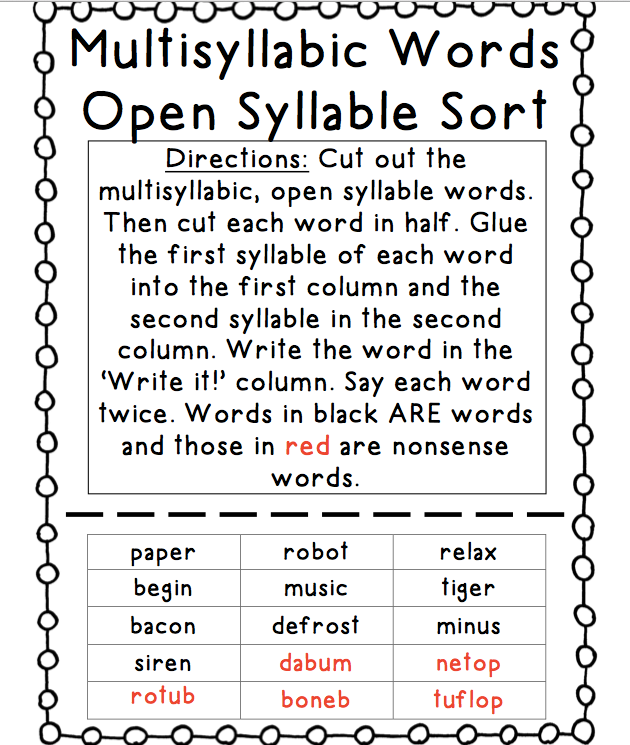
Games for dividing words into syllables
Offer the child exercises to develop the skill of dividing into syllables. They can in a playful way.
nine0013 Clap the syllables in the word gamePurpose: to teach children to divide a word into syllables based on aids (slapping).
Game progress : the presenter shows the picture, pronounces the word together, without dividing it into syllables. The player must slap this word without saying it out loud. For each correct execution, a point (chip) is given. The one with the most points (chips) at the end of the game wins.
For the game, you should select words from a different number of syllables, from 1 to 5. You cannot present words with the same number of syllables in a row. In order to develop a vocabulary, it is worth choosing words on a specific topic.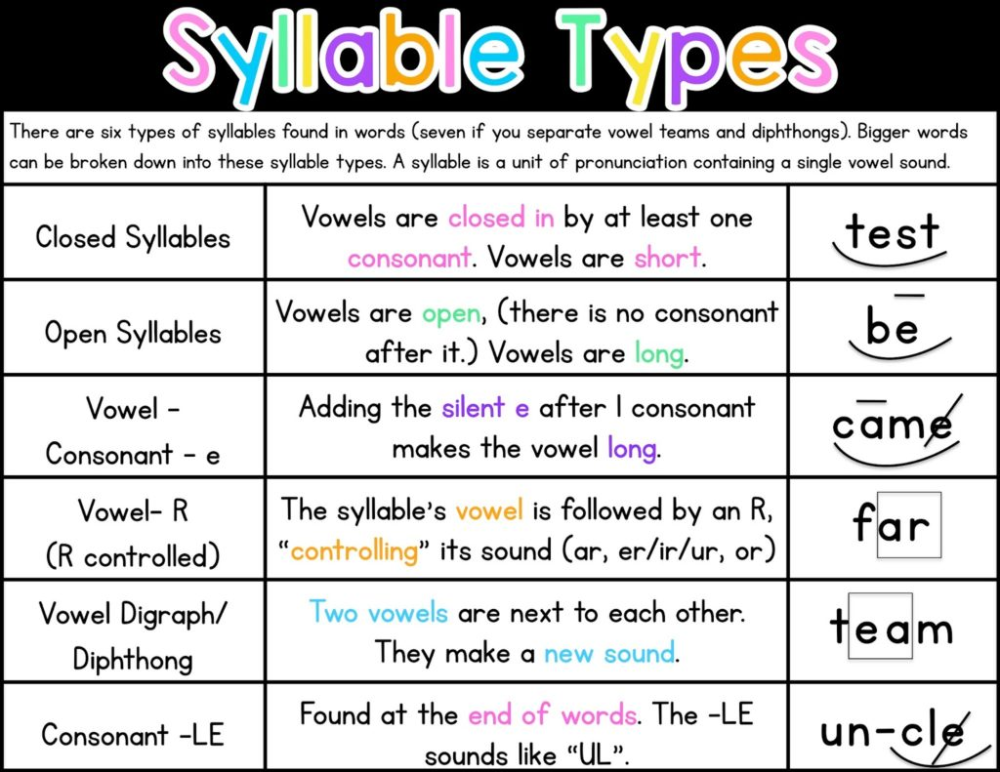 nine0016
nine0016
Game "Who has the longest track"
Purpose: working out the pronunciation of words by syllable, activating the vocabulary of children on a given topic.
Game progress : children stand at the start and take turns stepping forward along the lined squares, making one step-square for each syllable of the word pronounced. The facilitator invites the children to come up with and name words on a lexical topic, for example, “Flowers”, “Birds”, etc. Marking the squares helps determine the winner (the one who was able to pronounce the longest word and was ahead of everyone wins) and shows how many syllables are in the spoken word. For example, on the topic “Flowers”, those children who remember the names of 4 syllables will win: not-for-bud-ka, ko-lo-kol-chik, and those who pronounce words of 3 syllables will lose: ro-mash- ka, va-si-lek, or from 2 syllables: ro-za, pi-on. nine0016
The game "Who will collect the most pictures"
Purpose of : to teach children to distinguish one-syllable and two-syllable words by ear.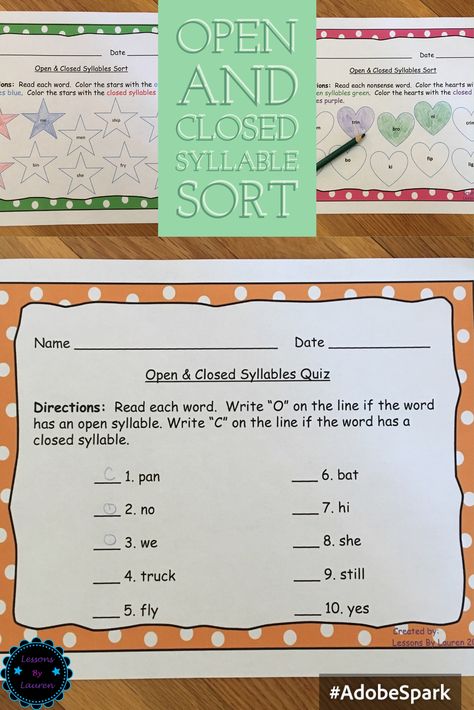
Game progress : Players have numbers 1 and 2 (each has two numbers). At the leading picture (you can use the set from the previous game). The host shows the picture and calls it, and the children raise the number corresponding to the number of syllables in the word. The picture is awarded to the one who first counted the syllables in the word and raised the corresponding figure. The game continues until the pictures for presentation run out. Then the number of pictures for each player is counted. The one with the most pictures wins. nine0016
The game "Who will collect the most pictures"
Purpose: to teach children to distinguish one-syllable, two-syllable and three-syllable words by ear.
Game progress: players have numbers 1, 2, 3 (each has three numbers). At the leading picture (you can use the set from the previous game). The host shows the picture and calls it, and the children raise the number corresponding to the number of syllables in the word.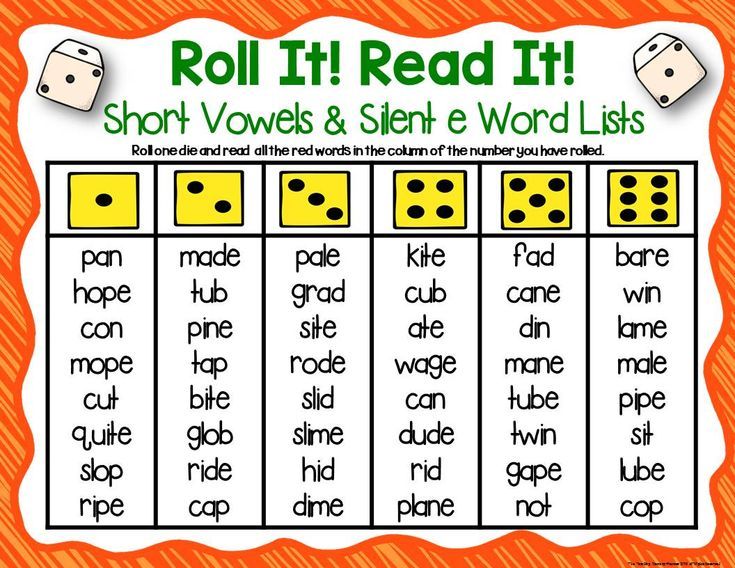 The picture is awarded to the one who first determined the number of syllables and raised the desired number. The game continues as long as there are pictures to present. Then the number of pictures for each player is counted. The one with the most pictures wins. nine0016
The picture is awarded to the one who first determined the number of syllables and raised the desired number. The game continues as long as there are pictures to present. Then the number of pictures for each player is counted. The one with the most pictures wins. nine0016
Add a syllable game
Purpose : teaching conscious reading of syllables from two open syllables.
Game progress: the children have cards with the first syllables of words (four cards each), the host has the second syllables. Children lay out the syllables in a column, from top to bottom. The host raises a card with a syllable and reads it. Children choose the necessary syllables, put cards with syllables to the corresponding beginning of each word and read the words in their entirety. The winner is the one who has collected and read all his words first. nine0016
With the same set of cards you can play without a leader, this is a more difficult version of the game.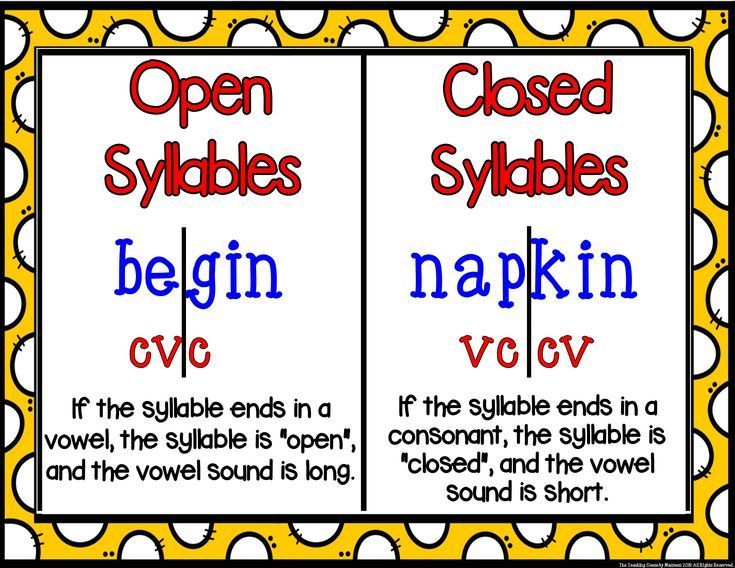 In this version, it is not the host who voices the second syllable, but each player. In the center of the table are a stack of cards with the second (final) syllables inscribed down, for children - the first syllables. Children take turns opening the top syllable; each child evaluates whether the syllable fits his syllables, and if so, puts it in the right place in the word, and if not, returns the syllable to the bank, to the very bottom of the pile.
In this version, it is not the host who voices the second syllable, but each player. In the center of the table are a stack of cards with the second (final) syllables inscribed down, for children - the first syllables. Children take turns opening the top syllable; each child evaluates whether the syllable fits his syllables, and if so, puts it in the right place in the word, and if not, returns the syllable to the bank, to the very bottom of the pile.
| 1 syllable | 2 syllable | 1 syllable | 2 syllable |
| Li | for | En | ka |
| Ca | sha | Si | la |
| Lu | Ms. | nine0214 More | |
| Chu | to | Ce | lo |
You need to constantly train to divide words into syllables.
Children like the element of the game, when syllables can be chanted, like in a stadium, or sung, - primary school teacher Natalya Kryuchkova shares her experience.
A list of words on various topics that can be used in games
Trees : acacia, baobab, birch, elm, oak, spruce, willow, chestnut, cedar, cypress, maple, linden, larch, aspen, alder, mountain ash, saxaul, pine, poplar, thuja. Flowers : aloe, aster, cornflower, victoria, carnation, jasmine, iris, cactus, marigold, calla lilies, clover, bluebell, water lily, lavender, lily of the valley, lily, lotus, buttercup, poppy, mallow, daisy, lungwort, mimosa , nasturtium, forget-me-not, dandelion, orchid, peony, snowdrop, mignonette, rose, chamomile, lilac, yarrow, ficus, phlox, chrysanthemum, bird cherry, edelweiss. nine0016 Vegetables : eggplant, pea, melon, cabbage, potato, corn, onion, carrot, cucumber, pepper, tomato, radish, turnip, radish, pumpkin, dill, beans, garlic.

